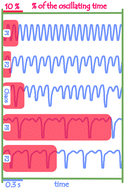Despite the fact that the majority of the catalytic electro-oxidation of small organic molecules presents oscillatory kinetics under certain conditions, there are few systematic studies concerning the influence of experimental parameters on the oscillatory dynamics. Of the studies available, most are devoted to C1 molecules and just some scattered data are available for C2 molecules. We present in this work a comprehensive study of the electro-oxidation of ethylene glycol on polycrystalline platinum surfaces and in alkaline media. The system was studied by means of electrochemical impedance spectroscopy, cyclic voltammetry, and chronoamperometry, and the impact of parameters such as applied current, ethylene glycol concentration, and temperature were investigated. As in the case of other parent systems, the instabilities in this system were associated with a hidden negative differential resistance, as identified by impedance data. Very rich and robust dynamics were observed, including the presence of harmonic and mixed mode oscillations and chaotic states, in some parameter region. Oscillation frequencies of about 16 Hz characterized the fastest oscillations ever reported for the electro-oxidation of small organic molecules. Those high frequencies were strongly influenced by the electrolyte pH and far less affected by the EG concentration. The system was regularly dependent on temperature under voltammetric conditions but rather independent within the oscillatory regime.

You have access to this article
 Please wait while we load your content...
Something went wrong. Try again?
Please wait while we load your content...
Something went wrong. Try again?


 Please wait while we load your content...
Please wait while we load your content...